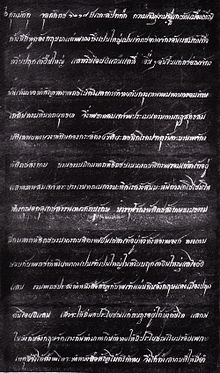Bowring treaty

The Bowring Treaty (English Bowring Treaty ) is an agreement which was concluded on April 18, 1855 between the United Kingdom and the Kingdom of Siam and opened Siam to world trade . The treaty was signed by Siam's King Mongkut (Rama IV) and the British diplomat and Governor of Hong Kong Sir John Bowring .
prehistory
A previous agreement, the Burney Treaty, between Siam and the United Kingdom was signed as early as 1826. The new agreement in Victorian times liberalized trade rules and improved import and export opportunities.
Sir John Bowring requested that the treaty remove the following restrictions:
- The "hideous clause" that brought British affairs in Siam entirely under Siamese jurisdiction.
- The clause that allowed Siamese officials to prohibit British merchants from building, renting or buying shops and houses.
- The clause which authorized provincial governors to prohibit British merchants from trading in any locality.
- The clause that banned the opium trade .
- The clause with which a Maßzoll of 1700 baht per fathoms (Engl. "Fathom") was raised for British ships that imports to the port of Bangkok. This clause also prohibited the export of rice - both raw rice (" paddy rice ", unhulled rice) and husked rice ("natural rice").
Content of the contract
The agreement allowed foreigners to trade freely in Bangkok and the abolition of high royal taxes on foreign trade. The following is a summary of the contractual conditions:
- British affairs are subject to consular jurisdiction . This is the first time that Siam has granted foreigners extraterritoriality .
- Britons are given the right to trade freely in all ports and to settle permanently in Bangkok. They are allowed to purchase real estate in the Bangkok area; specifically in the area more than four miles from the city wall but less than 24 hours from the city (measured by the speed of local boats). Brits are also allowed to travel freely inland with a consul passport.
- Customs duties will be abolished and import and export duties will be set.
- The import duty is set at 3 percent for all items with two exceptions: Opium is tax free, but it has to be sold to opium farmers and gold and silver bars ( bullion ) are tax free.
- When exporting, items are only taxed once, regardless of whether the tax is domestic tax, transit duty or export duty.
- British traders are allowed to buy and sell directly from Siamese without third party interference.
- The Siamese government reserves the right to ban the export of salt , rice and fish if they are considered to be in short supply.
Framework
Despite the official name "Treaty of Friendship and Commerce between Her Majesty and the Kings of Siam", critics speak of an unequal treaty . With Britain demonstrating its military might in China during the First Opium War , Siam was in a weak negotiating position and could hardly have prevented the opening to Western trade.
Siam's fears were reinforced by the fact that five years earlier negotiations between Sir James Brooke , the white Raja of Sarawak and British envoy, and Siam's King Nang Klao (Rama III) had failed, leading Brooke to threaten Britain's gunboat policy . In addition, the European expansion efforts in Southeast Asia have long been perceived as a threat by Siam, which forced Siam to conclude a treaty that increasingly restricted the country's fiscal and legal autonomy.
Effects
The agreement had an impact on bilateral agreements with other countries, which were based on the rules of the Bowring Treaty. The agreement helped keep foreign powers from interfering in Siam's internal affairs and allowed Siam to remain independent. Today the Bowring Treaty is credited with having led to the economic development of Bangkok by creating a framework in which free multilateral trade was made possible in Southeast Asia , particularly between China , Singapore and Siam.
Web links
Individual evidence
- ↑ a b Siam . In: Encyclopædia Britannica . 11th edition. tape 24 : Sainte-Claire Deville - Shuttle . London 1911, p. 2 (English, full text [ Wikisource ]).
- ↑ a b James C. Ingram: Economic Change in Thailand 1850-1970. Stanford University Press, Stanford CA 1971, ISBN 0-8047-0782-0 , pp. 33-34
- ↑ a b c Ode to Friendship, Celebrating Singapore - Thailand Relations: Introduction . National Archives of Singapore. 2004 . Retrieved August 30, 2007.
- ↑ Impacts of Trade Liberalization under the Agreement on Agriculture (AoA) of the World Trade Organization: A Case Study of Rice . Rural Reconstruction and Friends Alumni, Asia Pacific Research Network. December 1, 2002. Retrieved August 30, 2007.
- ↑ Patcharee Thawonphayak: The development of the state school system in Thailand from 1851 to 1997. A study on the historical development of the state school system in Thailand. 1997, p. 14, (Passau, Universität, Dissertation, 1998).